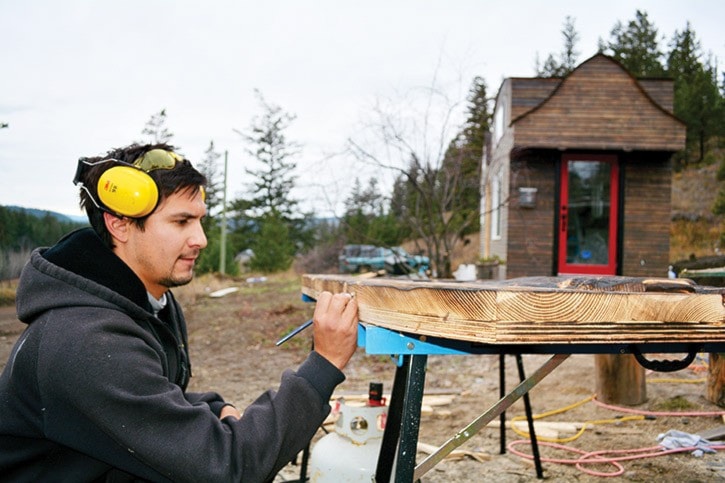When a home is 280 square feet every inch counts, says Robert Johnson as he stands inside the tiny house he is building for his parents at Esk’et (Alkali Lake) First Nation, 45 minutes west of Williams Lake.
“Outside it looks tiny, but the idea is to make it feel spacious inside,” he smiles as he nods toward the curved rafters, two lofts and round windows.
Inside the bathroom, he pulls out a hidden shelf behind the shower for storing supplies and in the kitchen area shows where he’s extended the counter slightly to allow for an eating area.
Robert is a journeyman carpenter.
This is the first tiny house he has built.
After he and his wife Bettina looked at plans of other tiny houses they decided to design their own.

“We felt we could make it really interesting and use our creativity,” Robert says.
The front door is rounded on the top and has a carved scene of a bear and salmon.
For the siding, they’ve used pine from Howard and Beatrix's Linde Mill and employed an old Japanese treatment technique — Shou Sugi Ban — where the wood is charred to help it resist mould and moisture.
To meet the challenges of cold Cariboo winters and make the house energy efficient, they’ve installed closed cell spray foam insulation, an air exchange unit, a gas fireplace converted to propane, a propane stove and fridge, and an on-demand hot water heater.
“We haven’t seen the air exchange yet in tiny houses, but we’re learning it is do-able,” Bettina says.
The idea of starting their business, which they’ve named Esk’et Tiny House, was prompted by their desire to offer people the opportunity to get into the housing market.
“When the tiny house movement started in Portland, Oregon it was about being less materialistic,” Bettina says.
“For us it wasn’t necessarily that, but more about seeing people prosper.”
It gives people freedom because tiny houses can be paid off faster, she adds.
If Esk’et Tiny House is successful, the Johnsons envision employment opportunities for the community and a chance for the “very creative” people of Esk’et to share their talents.
Last February the Johnsons left Victoria where they had been living and working for a decade, and moved to Esk’et with their three children to be closer to family.
“We are trying to see if this could be a business,” Robert says of the tiny houses. “Honestly it is hard because it is something new for this area.”
Bettina and Robert say living at Esk’et is an honour.
“This community is well-known for its recovery,” Bettina adds. “The timing for us is good because we can encourage others who are doing great things.”
Tiny houses are built on a trailer so they can be moved, and are constructed to maximum widths and heights to fit under an overpass, power lines or bridges without requiring a transportation permit.
Their trailer was made to carry 11,000 pounds and can be pulled by something like a ranch truck or hooked up to a U-haul.
For people curious about the tiny house project, the Johnsons will be holding an open house on Saturday, Nov. 7 between 2 and 5 p.m.
They live on Wagon Road, the first place to the right. Everyone is welcome.
